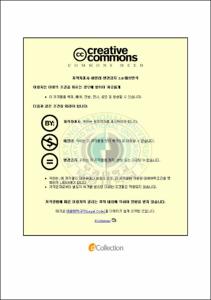김기림의 장시 「기상도」와 ‘장시론’ 연구
- Alternative Title
- A Study on the Long Poem 「Kisangdo」and 'Long Poetic Theory' of Kim Ki-Rim
- Abstract
- Kim Ki-Rim, as a leader of modernism in our modern history of poetry in 1930's, was a poetry critic and poet who established his poetics by introducing and accepting Western modernism. Studying in Japan twice and majoring English literature prepared him to accomplish the achievements.
This study attempted to examine the influential relationship between Kim Ki-Rim's poetics and poetry. Therefore, ‘Long Poetic Theory’ was examined in his poetics while the relations between the theory of poetry which he had insisted and poetry were defined. Long poems in ‘the theory of Long poems’ meant ‘a new poem’ in contrast with previous poetry and ‘a new poem’ had a close relationship with the acceptance of Pound and Eliot's poetics. The methods of conscious creation to write 'a new poem' developed to Long poems 「Kisangdo」.
Long poems have more than 200 verses in the length and take account of the intervention of trends and social situations with regard to the subjects and subject matters. In addition, such subject matters of trends and social situations are reorganized for the unity and consistency of the works. Based on the concept of Long poems,「Kisangdo」 is considered to be the first Long poem in Korean modern poems. 「Kisangdo」, the first modern Long poem, appeared as the experiment of ‘Long Poetic Theory’, well prepared in Kim Ki-Rim's ‘Long Poetic Theory’ and then the status is clearly understood by influencing modern Long poems.
The interrelationships which Kim Ki-Rim insisted between ‘Long Poetic Theory’ and 「Kisangdo」are following.
Firstly, it is the prose of「Kisangdo」. Kim Ki-Rim, who insisted the prose of Long poems, dividing the types of poems into short poems and long poems, emphasized the prose, revealing inconsistencies of the times by expressing his ideas with pictorial patterns as suggesting descriptive stories: racial discriminations by white people, modern people who attempt suicide, the life of Korean people under Japanese colonial rule, dictators’ desk theories and etc.
Secondly, it is the colloquialism of「Kisangdo」. It is insisted that modern poems have daily conversations which have breathing, conversational styles of questioning and answering were noticeably used in 「Kisangdo」, and the differences were easily noticed by marking 「」for conversational parts.
Thirdly, it is 「Kisangdo」's criticism on reality. It is insisted that the poet's interpretation of the era and criticism of culture and it is considered to be possible for Long poems to criticize the era of 1930'sand the reality of Korean colony by criticizing the racial discriminations against black people, the corruption of Christianity, modern materialism, and incompetent dictators.
Fourthly, it is the organizational unity of 「Kisangdo」. While the criticisms on Long poems are caused by the lack of unity in complicated compositions, it is insisted that the criticism is not necessary because there is the unity in diversity. Such unity in diversity was seen as the figures and directions for prior typhoon's arrive, typhoon's arrive, and later typhoon's arrive and the presentation of 'city's bulletin board.'
Fifthly, it is the pictorial styles of 「Kisangdo」. Kim Ki-Rim emphasized the pictorial attributes in 'new poems' and preferred Long poems which harmonize music and picture. Such pictorial descriptions were well presented in 「Kisangdo」through detail descriptions which showed the prior situation of typhoon occurrences and the damages when typhoon arrives.
However, ‘Long poems’ and 「Kisangdo」 which Kim Ki-Rim began with ‘new poems’ have limitations. Firstly, although the establishments of theories to create ‘new poems’ were influences and acceptances, the fact that 「Kisangdo」imitated Eliot's techniques and 「The Waste Land」created the limitation. Secondly, he emphasizes intellect influenced by Western modernism. His emphasis on intellect represented by using lots of foreign words in 「Kisangdo」, foreign names of places, and foreign names. Such abuse of foreign languages, place names, names is inconsistent with the criticism on reality emphasized in ‘Long poems.’
- Issued Date
- 2008
- Awarded Date
- 2008. 2
- Type
- Dissertation
- Publisher
- 부경대학교 대학원
- Alternative Author(s)
- Kim, Yeon Jung
- Affiliation
- 부경대학교 대학원
- Department
- 대학원 국어국문학과
- Advisor
- 남송우
- Table Of Contents
- Ⅰ. 서론 = 1
1. 연구 목적 = 1
2. 연구사 검토 및 문제제기 = 3
3. 연구방법 및 범위 = 15
Ⅱ. 예비적 고찰 = 17
1. 김기림의 생애 = 17
2. 김기림의 시와 시론 = 20
3. 김기림의 장시 「기상도」 = 34
Ⅲ. 장시의 개념과 김기림의 ‘장시론’ = 37
1. 장시의 개념 = 37
2. 김기림의 ‘장시론’ = 40
Ⅳ. 「기상도」와 ‘장시론’의 상관성 = 43
1. 「기상도」의 산문성 = 43
2. 「기상도」의 구어성 = 51
3. 「기상도」의 현실비판성 = 56
4. 「기상도」의 구성의 통일성 = 60
5. 「기상도」의 회화성(繪畵性) = 65
Ⅴ.「기상도」와 ‘장시론’의 의의 및 한계 = 70
Ⅵ. 결론 = 77
참고문헌 = 80
- Degree
- Master
- Files in This Item:
-
-
Download
 김기림의 장시 「기상도」와 ‘장시론’ 연구.pdf
기타 데이터 / 891.5 kB / Adobe PDF
김기림의 장시 「기상도」와 ‘장시론’ 연구.pdf
기타 데이터 / 891.5 kB / Adobe PDF
-
Items in Repository are protected by copyright, with all rights reserved, unless otherwise indicated.